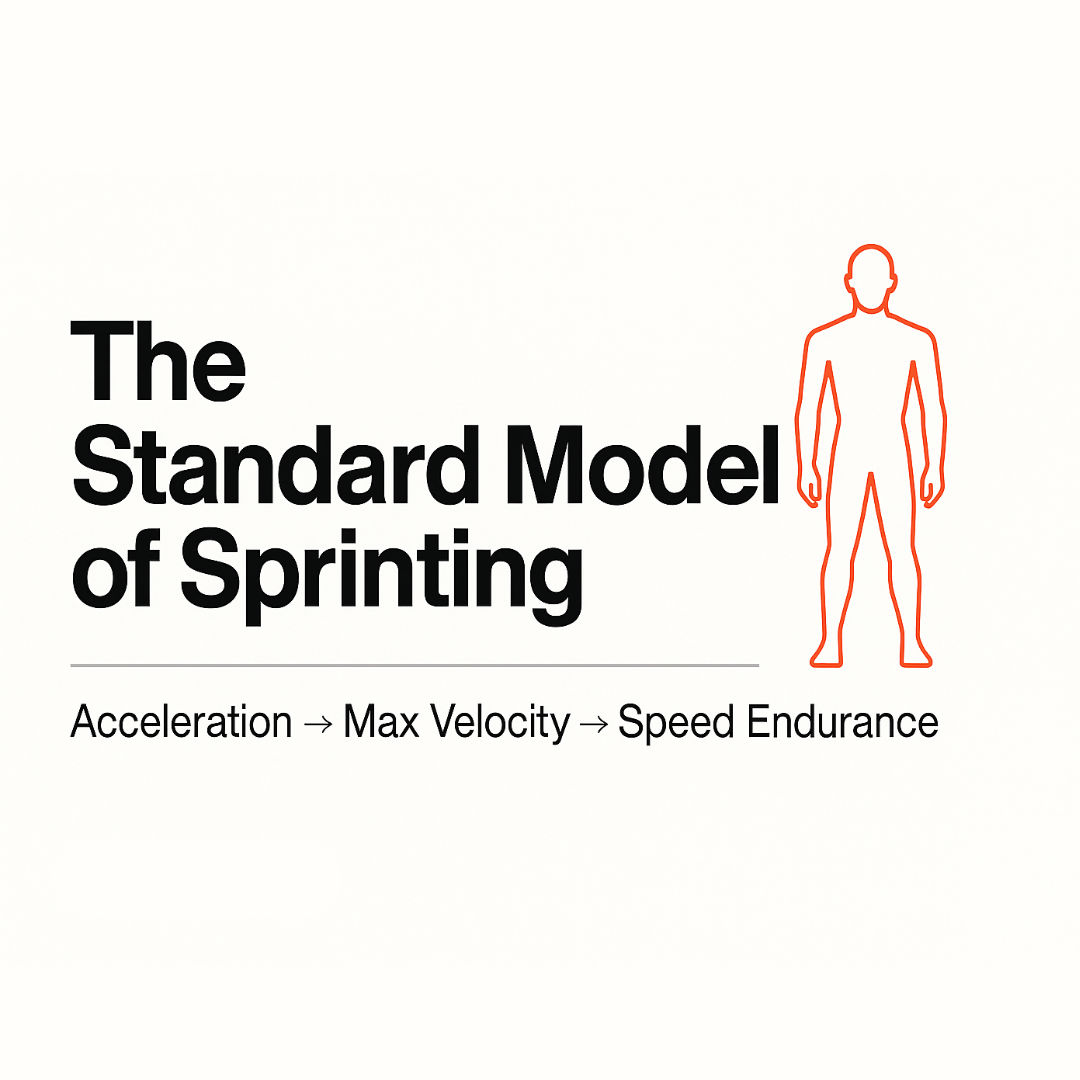
The Standard Model of Sprinting: Why Modern Biomechanics Has Changed the Game
Discover how modern biomechanics is reshaping sprint training, replacing outdated “base building” with max velocity and acceleration-first methods.

Strength isn’t just “how much weight you can lift.”
In sprinting, strength is the ability to produce and absorb tension — to generate force quickly, then withstand it without collapsing. Biomechanically, that means controlling the eccentric (lengthening) phase before rebounding into the concentric (shortening) phase.
Think of strength as a conversation between your muscles and the ground. Every stride demands you accept force, stabilize it, and redirect it forward. That cycle happens in less than 0.1 seconds.
In physics terms, sprinting performance depends not just on force production but on force application efficiency… how much of your strength you can use in the direction of movement during ground contact.
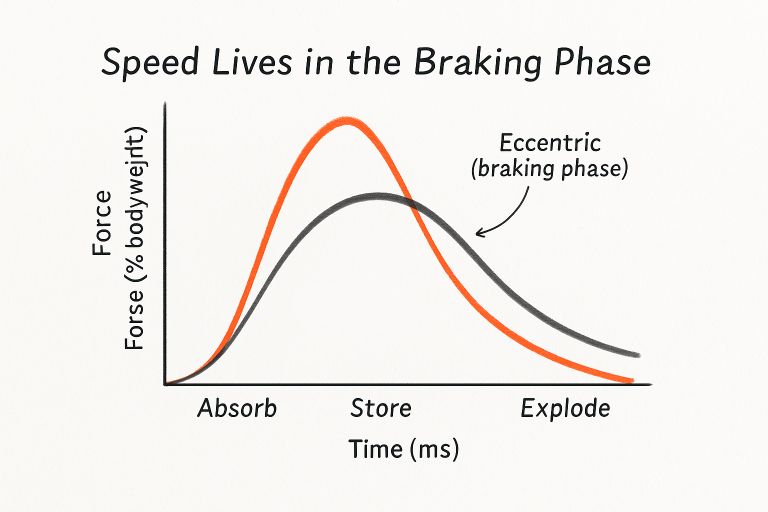
If maximal strength made you fast, powerlifters would dominate the 100 meters. They don’t — because sprinting is about expressing force rapidly, not simply generating more of it.
A car with 600 horsepower isn’t faster if its tires can’t grip the road. Likewise, an athlete with a 500-pound squat isn’t faster if they can’t stabilize and recycle that force elastically.
Strength is potential. Eccentric control turns potential into speed.
Research backs this up.
In other words: once you’re “strong enough,” the differentiator becomes how you use that strength.

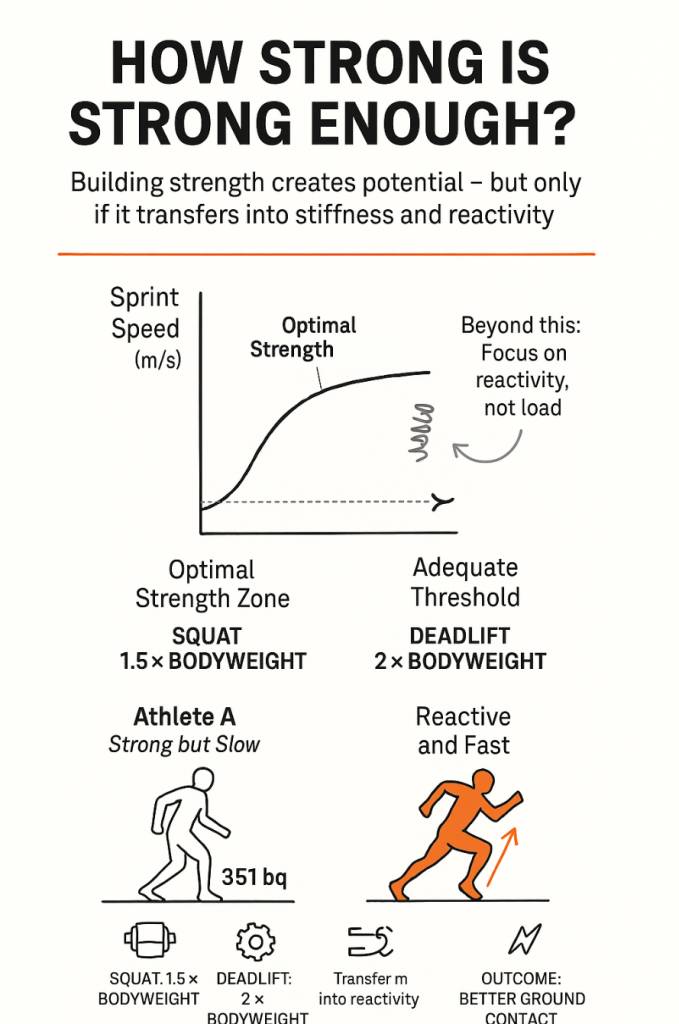
Every athlete needs a base of maximal strength.
A simple benchmark:
Beyond these levels, chasing heavier numbers often produces diminishing returns. The goal isn’t to lift more — it’s to move better and apply your existing strength more efficiently.
Imagine two sprinters:
Athlete B wins every time. Strength only helps if it enhances stiffness and reactivity.
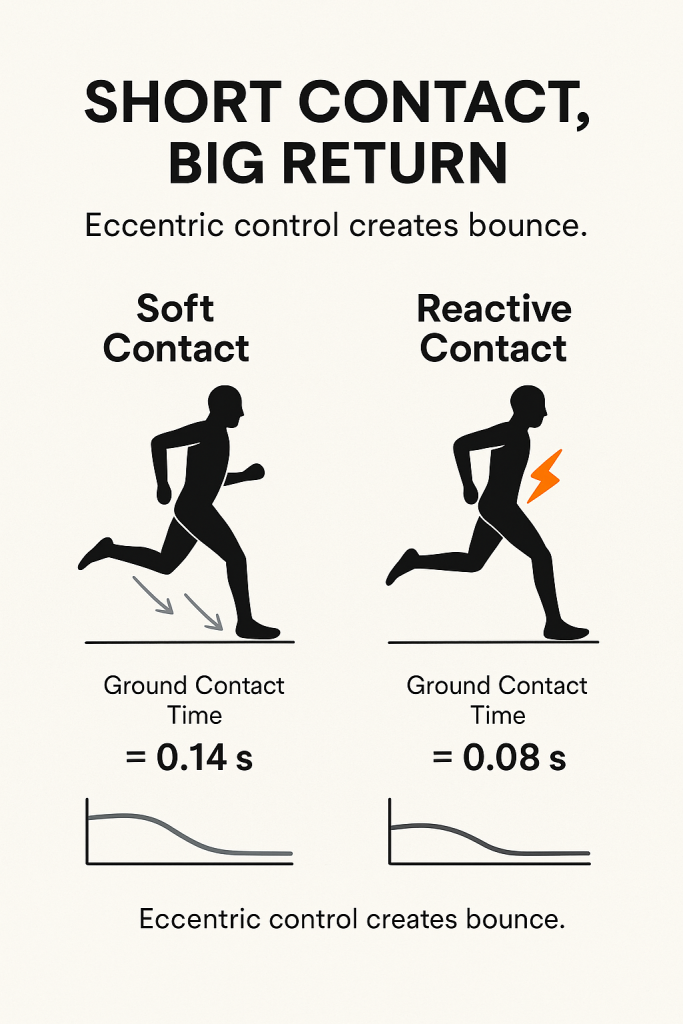
Eccentric strength is your ability to resist and control force while muscles lengthen — the braking action before an explosive push.
In sprinting, this happens during every foot strike. When the foot contacts the ground, the body’s momentum drives force upward through the kinetic chain. Weak athletes “give” under that tension — their knees buckle, hips drop, and force dissipates. Strong athletes stay rigid, absorbing and returning energy like a coiled spring.
A flat basketball doesn’t bounce because it gives too much. A pressurized basketball rebounds with force. The same principle applies to your legs.
Eccentric training builds that internal “air pressure.” It teaches the body to lock, load, and release energy efficiently — enhancing stiffness, tendon elasticity, and reactive speed.
At top velocity, sprinters don’t push the ground — they bounce off it.
Ground contact times drop to ~0.08 seconds, far too short for deliberate muscular contraction. Instead, tendons store and release elastic energy, a process made possible by high eccentric strength.
This “reflexive rebound” separates smooth, fast runners from muscular grinders.
Watch an elite sprinter — hips stay high, legs stiff, heels barely touch.
Watch a novice — knees collapse, hips sink, strides look heavy.
The difference?
Eccentric control → stiffness → elastic recoil → speed.
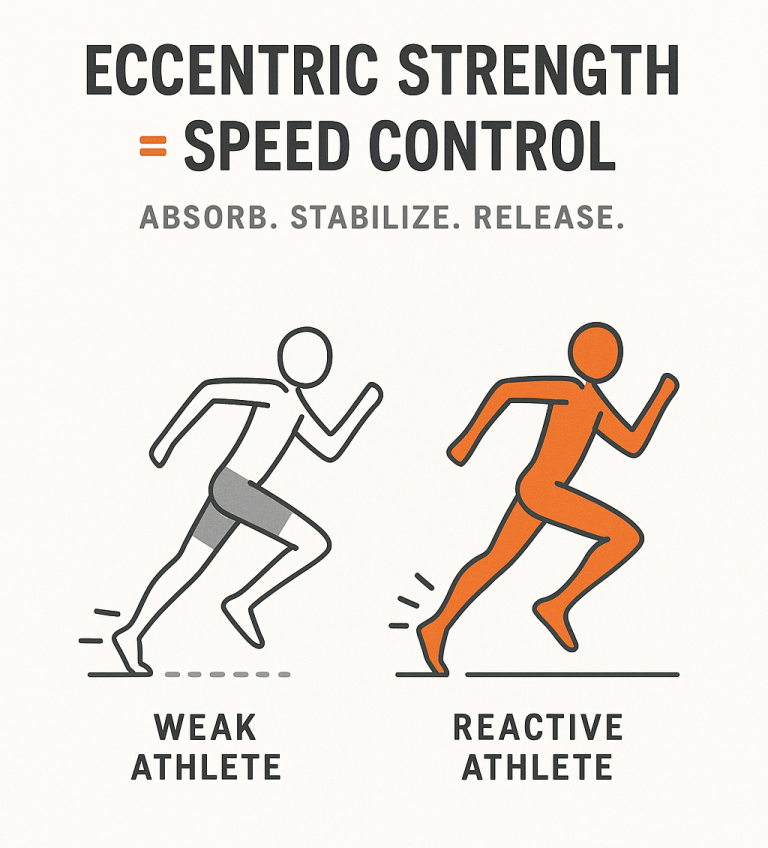

Strength isn’t just physical — it’s neurological.
Muscle power depends on how effectively your nervous system recruits and fires motor units.
Every stride is a neural event.
The faster your nervous system can activate muscle fibers, the more force you can produce in shorter time frames. That’s why sprinters improve not only by building muscle, but by improving motor unit synchronization and firing rate — what’s known as rate coding.
In short:
Strength = Motor Unit Recruitment × Firing Frequency × Muscle Size
Heavy lifting trains recruitment. Explosive and eccentric work trains firing speed and coordination. Sprinting refines both under real-world conditions.
Elite sprinting is 90% reflexive.
By the time the foot hits the ground, there’s no conscious control — the body automatically stiffens and rebounds through the stretch–shortening cycle.
According to Weyand et al. (2000), top-speed sprinters apply up to five times their bodyweight in less than one-tenth of a second. That’s not voluntary power; it’s stored elastic energy unleashed through well-trained reflexes.
Eccentric strength fortifies this loop by improving tendon stiffness and the speed of transition between eccentric and concentric phases — the amortization phase that defines bounce.
Before training reflexive qualities, you need enough raw material — basic strength and stability.
Focus on:
Each should emphasize a controlled lowering phase followed by a fast concentric drive.
This teaches muscles to absorb and release force effectively.
Elite sprinters typically develop extraordinary foot and ankle strength, stiffness, and coordination through specialized training that targets this critical system. Training methods like hill sprints, banded starts, and push-up starts specifically develop this quality.
Once base strength is established, it’s time to overload the eccentric phase.
Methods:
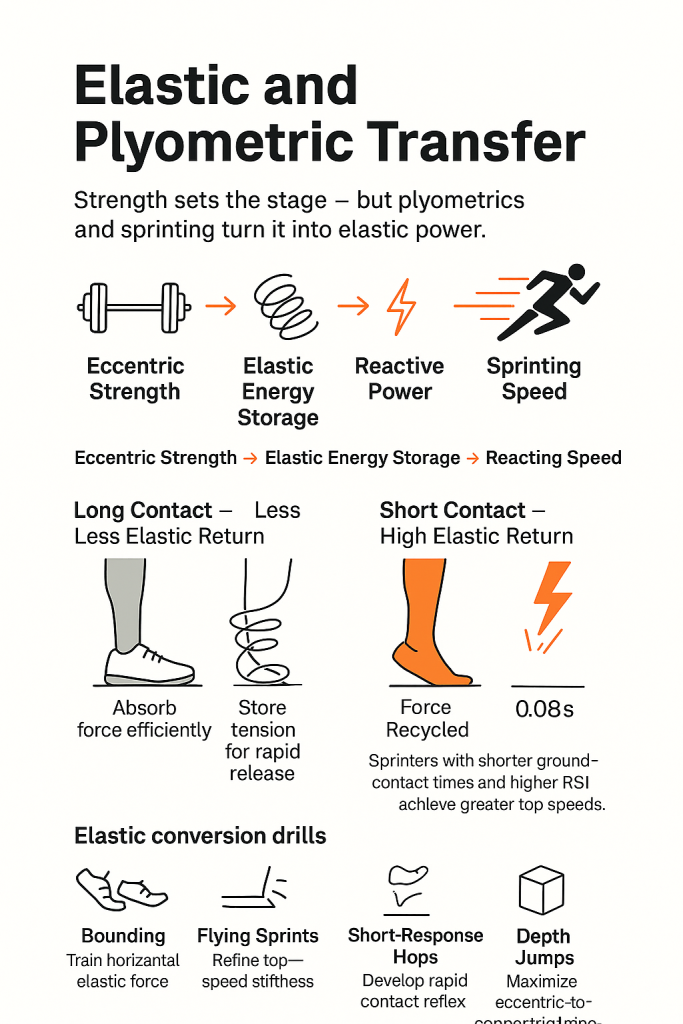
Strength doesn’t automatically become speed; it needs conversion.
Eccentric training sets the stage, but plyometrics and sprinting turn it into elastic power.
Drills like:
…teach the nervous system to recycle force efficiently under realistic timing constraints.
Research confirms that sprinters with shorter ground-contact times and higher reactive strength indices (RSI) achieve higher top speeds. Sprinting itself is the ultimate plyometric.
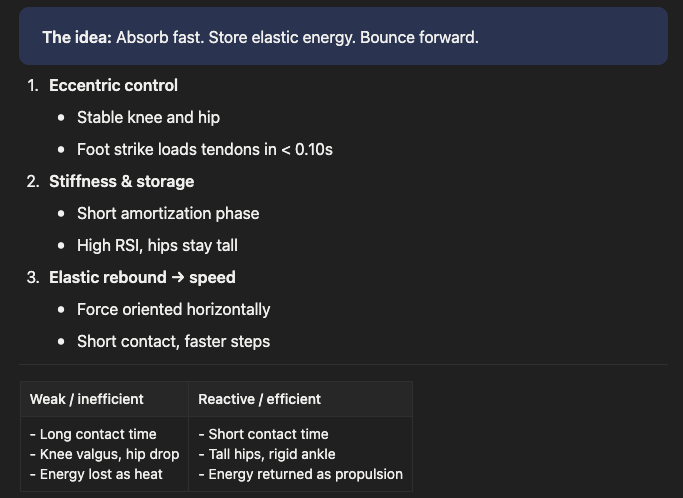
False. Beyond adequate base levels, chasing max lifts yields smaller gains and can even slow recovery.
Speed comes from expressing strength, not endlessly building it.
Not true. Heavy phases build the base, but high-frequency sprinting demands fresh legs. Rotate emphasis through phases: heavy → eccentric → elastic → reactive.
They’re complementary — if trained correctly.
Eccentric and plyometric methods merge the best of both worlds: the control of strength and the freedom of speed.
Strength alone won’t make you fast — but eccentric strength will make your speed useable.
Build enough raw strength, then shift your focus to absorbing, storing, and releasing force faster. That’s where elite speed lives.
Does strength training make you faster?
Yes — up to a point. Once foundational strength is achieved, improvements depend on eccentric and elastic training, not heavier lifts.
What is eccentric strength?
It’s the ability to resist and control force while muscles lengthen — crucial for absorbing impact and preparing for explosive movement.
How can I train eccentric strength?
Flywheel training, Nordics, depth drops, and controlled eccentrics develop the ability to brake and rebound efficiently.
Is sprinting itself strength training?
Yes. Each stride is a high-velocity eccentric–concentric cycle — the body acts like a spring, applying and reusing force.

Discover how modern biomechanics is reshaping sprint training, replacing outdated “base building” with max velocity and acceleration-first methods.
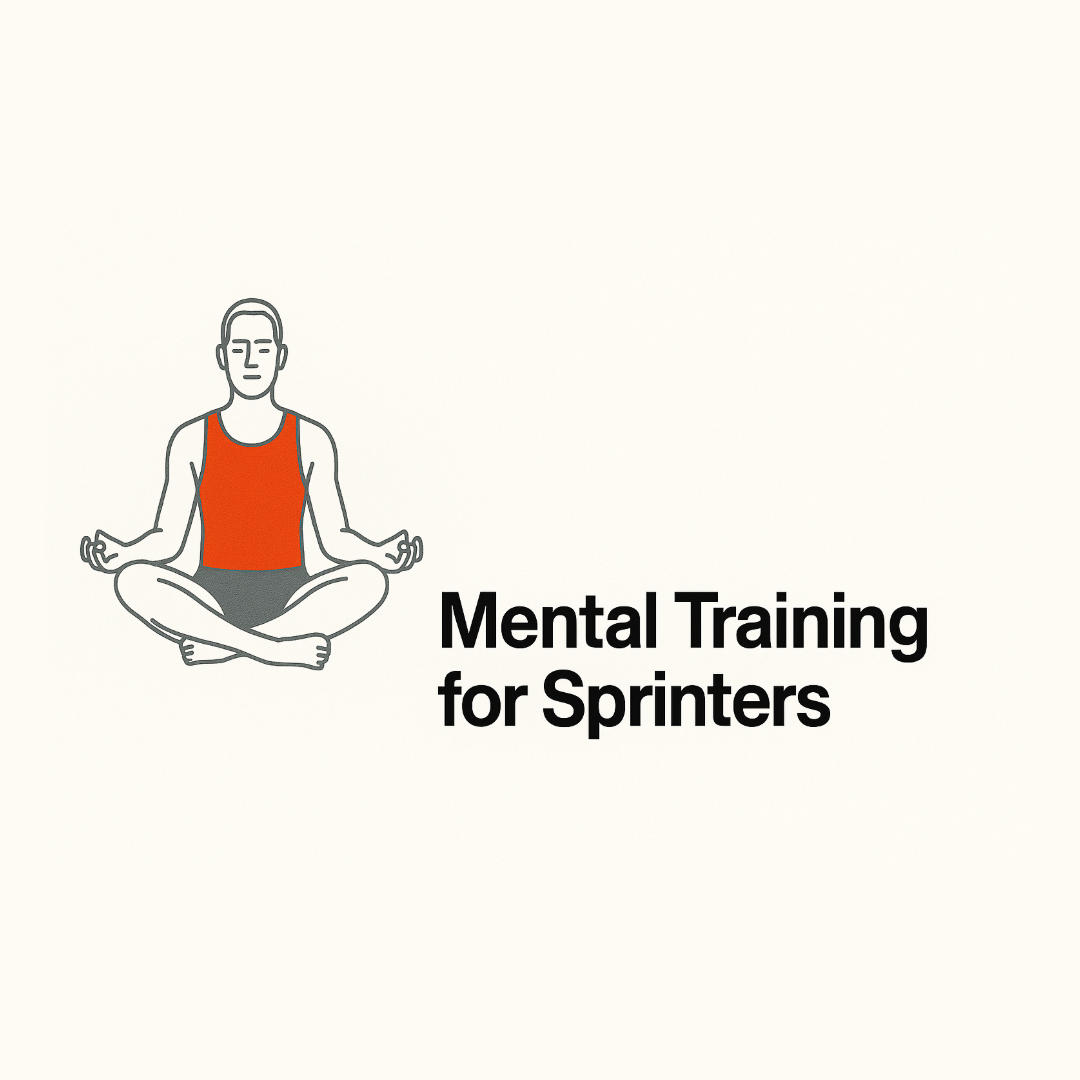
Unlock sprinting speed with proven mental training. Learn visualization, mindfulness, and sports psychology techniques to boost explosive performance.

Should sprinters focus on work capacity or speed quality? Discover the truth about GPP vs SPP and the real goal of sprint training.

